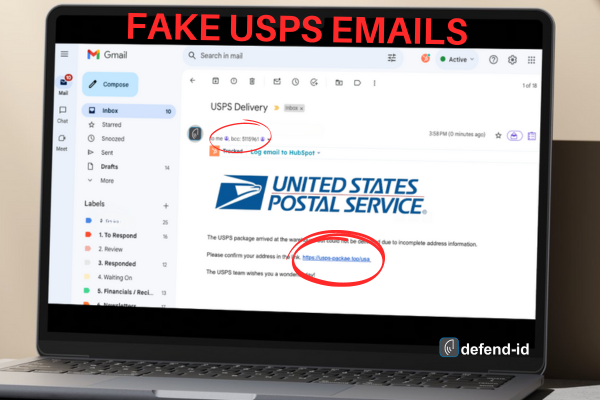Beware of Fake USPS Emails: Protect Your Personal Information
Understanding the Scam
Scammers are constantly evolving their tactics to deceive unsuspecting individuals, and one of the prevalent scams involves fake USPS emails. These emails often contain fraudulent information about an attempted or intercepted package delivery and prompt the recipient to click on a link to find out more about the delivery status. Unfortunately, clicking on this link can activate malware designed to steal personal information. Information such as usernames, passwords, and financial account numbers stored on your computer or mobile device.
How the Fake USPS Emails Scam Works
Scammers send emails that look convincingly like they are from USPS, using official logos and language to trick recipients. These fake USPS emails typically include:
- A Subject Line Indicating Delivery Issues: Subjects may read “USPS Delivery Failure Notification” or similar, indicating that there was an issue delivering a package.
- Fraudulent Delivery Information: The body of the email often states that a package was attempted to be delivered on a specific date, but for some reason, it could not be completed.
- A Malicious Link: Recipients are instructed to click on a link to print a delivery label or to find out more about the delivery status. Clicking this link can install malware on your device.
Once the malware is installed, it can log your keystrokes, steal your personal information, and gain access to your financial accounts.
Identifying Fake USPS Emails
To protect yourself from these scams, it’s crucial to recognize the tell-tale signs of fake USPS emails:
- Poor Grammar and Spelling Errors: Legitimate organizations typically do not send out emails with grammatical errors or spelling mistakes. Scammers often make these errors, so it’s a red flag if you notice them.
- Sense of Urgency: Scammers often create a sense of urgency, stating that immediate action is required, or there will be dire consequences. This tactic is meant to pressure you into acting quickly without thinking.
- Requests for Personal Information: USPS will never ask for personal information via email. If an email requests personal information under the guise of reconfirming details, it is likely a scam.
- Unusual Sender Email Address: Check the sender’s email address. Scammers often use addresses that look similar to official ones but may have slight variations or unusual domains.
- Unexpected Package Notifications: The USPS does not notify customers about package delivery attempts by email. If you receive such a message, it is best to assume it is fraudulent.
Real-life Examples of Fake USPS Emails
Customers being targeted will receive an email with a subject line like “USPS Delivery Failure Notification.” The email states that a package was attempted to be delivered on a certain date but could not be completed. It then instructs the recipient to click on a link to print a delivery label and take it to their local post office to pick up the package. This link, however, installs malicious software on the recipient’s computer, logging keystrokes and potentially obtaining personal identification information and account details.
Protecting Yourself from Fake USPS Emails and Email Scams
Here are some practical steps you can take to protect yourself from falling victim to fake USPS emails and other phishing attacks:
- Be Skeptical of Unsolicited Emails: Always be cautious of unexpected emails, especially those that claim you have a package waiting or need to take immediate action.
- Check the Sender’s Email Address: Look closely at the sender’s email address. Legitimate emails from USPS will come from an official domain, not a random or suspicious-looking address.
- Hover Over Links Without Clicking: Before clicking on any link, hover over it with your mouse to see the URL. If it looks suspicious or unfamiliar, do not click on it.
- Verify Information with USPS Directly: If you are unsure about an email, contact USPS directly using a verified phone number or their official website. Do not use any contact information provided in the suspicious email.
- Forward Suspicious Emails to USPS: If you receive a suspicious email, forward it to SPAM@USPIS.gov. This helps USPS investigate and address the issue.
- Keep Your Computer and Software Updated: Regularly update your operating system, antivirus software, and any other applications to protect against malware and other threats.
What to Do if You Clicked on a Link in Fake USPS Emails
If you have clicked on a link in fake USPS emails, take the following steps immediately:
- Disconnect from the Internet: Temporarily disconnect your computer from the internet to prevent further data transmission.
- Run a Full Virus Scan: Use your antivirus software to run a full system scan. Remove any detected threats.
- Change Your Passwords: Change the passwords for your email, financial accounts, and any other accounts that may have been compromised. Use strong, unique passwords for each account.
- Monitor Your Accounts: Keep a close eye on your financial accounts and credit reports for any unusual activity. Report any suspicious transactions to your bank or credit card company.
Conclusion
Scams are a growing threat, but with the right knowledge and precautions, you can safeguard your personal information. Always be wary of emails that seem suspicious, and remember that the USPS will never notify you about package deliveries via email. If in doubt, contact the USPS directly to verify the authenticity of any communication. Stay safe and protect yourself from fake USPS emails and other scams by following these simple guidelines.
By staying vigilant and recognizing the signs of a scam email, you can protect your personal information from falling into the hands of cybercriminals. Always be cautious when receiving unsolicited emails, especially those that request personal information or prompt you to click on links. Remember, it is better to be safe and verify the legitimacy of an email than to risk compromising your personal information.
